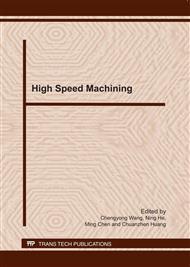[1]
G. Byrne, D. Dornfeld, B. Denkena. Advancing cutting technology, Annals of CIRP 52/2 (2003) 483–503.
DOI: 10.1016/s0007-8506(07)60200-5
Google Scholar
[2]
G. Poulachon, B.P. Bandyopadhyay, I.S. Jawahir, S. Pheulpin, E. Seguin, The influence of microstructure of hardened tool steel workpiece on the wear of PCBN cutting tools, International Journal of Machine Tool and Manufacture 43 (2003) 139-144.
DOI: 10.1016/s0890-6955(02)00170-0
Google Scholar
[3]
H.A. Kishawy, M.A. Elbestawi, Tool wear and surface integrity during high-speed turning of hardened steel with polycrystalline cubic boron nitride tools, J. Eng. Manuf. 215 (2001) 755–767.
DOI: 10.1243/0954405011518700
Google Scholar
[4]
Huang, Y., Dawson, T.G. Tool crater wear depth modeling in CBN hard turning. Wear 258 (2005) 1455-1461.
DOI: 10.1016/j.wear.2004.08.010
Google Scholar
[5]
Kumar, A.S., Durai, A.R., Sornakumar, T. Wear behavior of alumina-based ceramic cutting tools on machining steels. Tribology International 39 (2006) 191–197.
DOI: 10.1016/j.triboint.2005.01.021
Google Scholar
[6]
T. özel, T. Altan, Determination of workpiece flow stress and friction at the chip–tool contact for high-speed cutting, International Journal of Machine Tools & Manufacturing 40 (2000) 133–152.
DOI: 10.1016/s0890-6955(99)00051-6
Google Scholar
[7]
T.K. Harris, E.J. Brookes, C.J. Taylor, The effect of temperature on the hardness of polycrystalline cubic boron nitride cutting tool materials, International Journal of Refractory Metals & Hard Materials 22 (2004) 105–110.
DOI: 10.1016/j.ijrmhm.2004.01.004
Google Scholar
[8]
Tong Yanjiao, Zhang Hongtao, LiMan, Dong Hai. Influences of chamfer angle of PCBN cutting tool on the cutting forces and tool wear in dry turning hardened steel, Diamond & Abrasives Engineering. 158 (2007) 66-68.
Google Scholar
[9]
Y. Huang, S.Y. Liang, Cutting forces modeling considering the effect of tool thermal property-application to CBN hard turning, International Journal of Machine Tools & Manufacture 43 (2003) 307–315.
DOI: 10.1016/s0890-6955(02)00185-2
Google Scholar
[10]
Eu. -G. Ng, D.K. Aspinwall, D. Brazil, J. Monaghan, Modeling of temperature and forces when orthogonally machining hardened steel, International Journal of Machine Tools & Manufacture 39 (1999) 885–903.
DOI: 10.1016/s0890-6955(98)00077-7
Google Scholar


